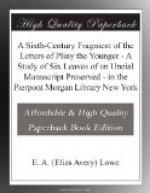[Footnote 56: See Ribbeck’s Virgil, Prolegomena, p. 152.]
[Footnote 57: See plate XVIII.]
[Footnote 58: Epist. III, i (plate IV).]
[Footnote 59: See plate XVIII.]
[Sidenote: Aldus and Budaeus compared]
It is of some importance to consider what Budaeus might have done to the text of Beroaldus had he treated it to a systematic collation with the Parisinus. Our fragment allows us to test Budaeus; for even if it be not the Parisinus itself, its readings with the help of B, F, and Aldus show what was in that ancient book. I have enumerated above[60] eleven readings of _{Pi}BF_ which are called errors by Keil, but of which nine were accepted by Aldus and five by the latest editor, Professor Merrill. In two of these (62, 33 and 64, 3), Budaeus, like Aldus, wisely does not harbor an obvious error of P. In two more (62, 16 and 65, 12), Beroaldus already has the reading of P. Of the remaining seven, however, all of which Aldus adopted, there is no trace in Budaeus. There are also nineteen cases of obvious error in the {sigma} editions, which Aldus corrected but Budaeus did not touch. I give the complete apparatus[61] for these twenty-six places, as they will illustrate the radical difference between Aldus and Budaeus in their use of the Parisinus.
[Footnote 60: See above, p. 47.]
[Footnote 61: The readings of
manuscripts are taken from Merrill,
those of the editions from Keil; in the latter case,
I use
parentheses if the reading is only implied, not
stated.]
60, 15 duplicia] MVDr{sigma}
duplicata _{Pi}BFGpa_
61, 12 confusa adhuc] MV{sigma}
adhuc confusa _{Pi}BFGpra_
18 milia passuum tria nec]
_{Pi}BFMV_(p?)_a_
milia passum tria et nec D
mille pastria nec r
mille pas. nec _{sigma}_
62, 6 doctissime] MV{sigma}
et doctissime r
doctissima _{Pi}BFDa_
et doctissima p




